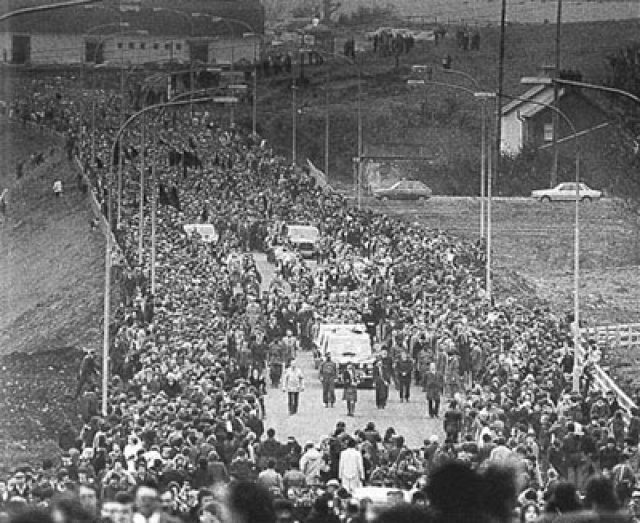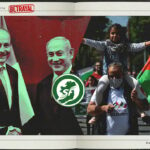
By Fra Hughes, Belfast – May 6, 2021
“They will not criminalise us, rob us of our true identity, steal our individualism, depoliticise us, churn us out as systemised, institutionalised, decent law-abiding robots. Never will they label our liberation struggle as criminal.”
Bobby Sands
The 1980 hunger strike led by Brendan Hughes, comprised of seven Republican male prisoners at Her Majesty’s Cellular Prison The Maze, also known as Long Kesh Prison Camp, and three female Republican prisoners at Armagh Women’s Prison, ended on December 1980 after 53 days.
An agreement was reached between the protesting prisoners and the prison authorities and by extension the British Government, ending the hunger strike. The prisoners were demanding the reinstatement of Special Category Status where Republican volunteers jailed for opposing politically and militarily the British occupation of Ireland were treated as POWs (Prisoners of War).
After the introduction of internment in 1971, where citizens of the state, mainly Catholics, with no criminal records were incarcerated without trial, having been convicted of no crime nor charged with any offence, in Long Kesh prison camp, these prisoners were basically deprived of their liberty. They were not allowed to wear their own clothes, have free association within the camp, drill, exercise, or hold educational classes. They ran the internment huts independently of the prison regime. Long Kesh had been used previously as a military camp and was brought into service as a make-shift prison camp along with a Royal Navy Ship berthed in Belfast Harbour, known as The Prison Ship Maidstone.
Both these facilities were needed because of the level of violence being exerted in society by the revolutionary Irish Republican Army and the counter revolutionary British Government armed and endorsed Ulster Defense Association and the more violent Ulster Volunteer Force.
RELATED CONTENT: No Border in the Irish Sea – the Northern Ireland Protocol
Long Kesh Prison Camp
Republican volunteers who were convicted of politically or militarily opposing the continued British Military occupation of the North East of Ireland, known as Northern Ireland, were imprisoned in Long Kesh Camp and were denied the Special Category Status enjoyed by the Internees.
Following a Hunger Strike by Republican Prisoners in 1972, Special Category Status was extended to those convicted of politically motivated offences. That strike, led by Billy McKee and involving 40 other inmates, succeeded in conferring Prisoner of War status to the IRA members in jail, and in effect the British told the world the IRA were an armed politically motivated revolutionary army involved in a war against the continued occupation of a part of Ireland by the British Government, its army, and civil enforcement structures.
It meant the IRA was engaged in a war of national liberation against a force occupying Government.
Hunger strikes were not new in the arsenal of Irish Republican Resistance.
Although used as a desperate last resort to resolve injustice, there are many precedents in Irish history for the use of hunger strikes. It was traditional for any person who was wronged by another to sit and fast at the door of those who had wronged them until justice was done.
Lord Mayor of Cork Terence MacSwiney’s Republican hunger strikers’ coffin leaving Brixton Prison, London, to return home to Ireland (1920).
This special category status was removed on March 1, 1976, when the new prison The Maze was opened adjacent to Long Kesh, and the British Government enacted its new prison policy of criminalisation of the Irish Republican prisoners, the movement outside, and its supporters at home and abroad.
All prisoners convicted after March 1, 1976 would be given prison uniforms and treated as criminals, made to carry out prison work and to obey orders given by the prison warders/regime and not their elected officers commanding the IRA volunteers held within the system.
After four years of prison protest, violence from the prison officers, failure by the British to implement the necessary changes to restore Special Category Status as agreed in the document ending the first hunger strike in 1980, a new hunger strike led by Bobby Sands, the OC of his wing, began on March 1, 1981. Exactly five years to the day Special Status Category was withdrawn by the Her Majesty’s Government.
The prisoners would join the hunger strike at staged intervals to build momentum, support and pressure for their demands to be met.
The first to go on hunger strike was Bobby Sands, IRA Belfast Brigade (convicted of possession of a gun), followed by Francis Hughes, IRA South Derry Brigade (killing a British soldier), Raymond McCreesh, IRA South Armagh Brigade (possession of a rifle, attempted murder of security forces, IRA membership), and Patsy O’Hara INLA Derry (possession of a hand grenade). Patsy was the Leader of the Irish National Liberation Army prisoners.
The prisoners claimed a hunger strike was unavoidable due to what they claimed was “British deceit and broken promises.”
Francis Hughes, referring to the failure of the British Government to implement the changes agreed to end the first hunger strike said, “The British know that any solution other than outright victory would be a defeat for them. It was in this frame of mind that they masterminded events leading into the new year, and when they foolishly thought they had won the day through their treachery they asked us for a white flag. Our action alone answers their hypocritical request and as before the message is loud and clear. There is no white flag and there shall be no surrender.”
As the hunger strike proceeded and more men joined the death fast, Margaret Thatcher was advised by the Secretary of State for Northern Ireland, a Minister and member of her own Cabinet, to sit tight and do nothing.
Outside the prison the momentum and support for the hunger strikers was growing. When a by-election was called in the Fermanagh South Tyrone Parliamentary Constituency due to the death of the sitting Independent Member of the British House of Commons Frank Maguire, an opportunity was presented which afforded the hunger strikers, the IRA and its supporters the ability to highlight prisoners demand.
After serious negotiations within the Nationalist community it was agreed by all other parties and individuals interested in contesting the seat that Bobby Sands would be nominated on 30 March 1981 to stand as a candidate for the vacant Parliamentary seat.
During the first seventeen days of his hunger strike Bobby had already lost sixteen pounds in body weight and was moved to the prison hospital.

Bobby stood as an Anti-H Block/Armagh Political Prisoner candidate and was opposed by Harry West, who stood for the Ulster Unionist Party. On 9 April 1981, Sands won the election with 30,492 votes against 29,046 for West.
Bobby Sands was elected with more votes by his constituents in Fermanagh South Tyrone than the British Prime Minister Margaret Thatcher received by voters in her constituency of Finchley.

Despite this historic election and the victory for the hunger striking prisoners and their demands to be treated as prisoners of war, tragically Bobby Sands would die twenty six days later on May 5, 1981, after 66 days on hunger strike.
He died as an Irish Republican felon convicted of militarily opposing the British occupation of Ireland. An Irish prisoner in a British jail on Irish soil, as the elected Parliamentary representative of the people of Fermanagh South Tyrone at the British Parliament. A member of the House of Commons with a larger vote than the British Prime Minister Margaret Thatcher.
Amid the fall-out and embarrassment of the British establishment that a Republican Prisoner could be democratically elected by the will of the people to the House of Commons, speedy legislation was rushed through Parliament barring prisoners serving 12 months or longer from standing for Parliament.
Owen Carron, who was Bobby Sands election agent, stood in the new by-election caused by the death of Bobby Sands MP and was elected in August 1981 to the same seat with an increased majority and became the youngest MP at the time. In line with most other Irish Republicans elected to the British Parliament, he did not take his seat.

“I was only a working-class boy from a Nationalist ghetto. But it is repression that creates the revolutionary spirit of freedom,” Bobby Sands used to say.
Bobby Sands’ death on May 5, 1981, was quickly followed by Francis Hughes’ death on 12 May, and the deaths of Raymond McCreesh and Patsy O’Hara on 21 May.
With four prisoners dead and many others on the death fast, Margaret Thatcher claimed that “faced with the failure of their discredited cause, the men of violence have chosen in recent months to play what may well be their last card.”
She was determined not make any concession to the republican inmates on free association within the prison or prison work. She would also claim the prisoners were committing pre-meditated suicide, and that wanted for murder, Margaret Thatcher and the prison regime were not responsible for their deaths. Nor would they intervene and force feed the prisoners.
With a general election in the South of Ireland and council elections in the North, nine protesting prisoners stood for election in Dail Eireann, the Irish Parliamentary elections, where both Kieran Doherty and Paddy Agnew were elected, with Joe McDonnell narrowly losing out a third seat, and a further twenty five council seats going to socialist republican parties in the north, it became apparent that the 1981 hunger strike heralded a new and sustained political support base for republican/socialist politics and candidates.
As the intransigence of Margaret Thatcher and the British Government seemed determined to let every republican hunger striker die, pressure was building on the prisoners and their families by sections of the Catholic Church to end the protest.
With more prisoners joining the fast and several already near death something had to give.
The resolve of the prisoners was unwavering. The determination of the British Government not to compromise had already led to the death of four fasting protesting prisoners. It was left to the families to decide ultimately how the hunger strike would be concluded.
The prisoners entered onto the their fast in the full knowledge that they might and would die if the British Government did not accede to their demands, but when a prisoner enters into a coma during the end stages of the fast where they lost consciousness and the body began to go into complete organ failure, the families would become their legal guardians.
A prisoner who joined the fast, who had watched his comrades die before him and knew many more were fasting behind him, closed his eyes for the last time slipping in and out of consciousness, a man who had made his peace with God and his farewells to his family, was preparing to embrace his death.
The families were then faced with an agonising decision, do they allow the prison authorities to intervene with their permission and save their childrens’ life by administering a life saving drip with nutrients, or do they stand aside and let their children die as was their decision before entering the coma?
In the end the fast had to be stopped.
Thatcher seemed determined to let more protesting prisoners die although who knows if many more deaths would have forced her hand?
I cannot imagine the agony faced by the prisoners on the hunger strike.
The pain, the pressure sores, losing their eyesight, emaciated bodies and ultimately having to face a premature death.
80% of the Republican prisoners were under 25.
Nor can I imagine the agony of decision faced by the families as their sons died one by one seemingly for nothing as their demands were not met.
In total TEN MEN DIED on the 1981 hunger strike.

Ten dead IRA/INLA Hunger Strikers 1981
RELATED CONTENT: Northern Ireland, That Tunnel and a Backdoor to Europe!
Died they in vain?
Within months of the election of Bobby Sands, Kieran Doherty and Paddy Agnew and the ending of the strike, all the demands were met by the prison service and the British Government.
The Great Escape of 1983, where 39 Irish Republican Prisoners took over one wing of the prison, arrested and subdued the prison guards, hijacked a prison food van, rammed the main gate and escaped from the prison into the local rural community was a direct result of the sacrifice of the ten men of 1981 and the concessions won.
Sinn Fein the Republican Party went onto develop the Ballot box in one hand and the Armalite in the other, the twin military and political election strategy eventually may have led to Sinn Fein becoming the second biggest Represented Party in the North with Martin McGuinness as Deputy First Minister and a Major Political Force in the South and could have contributed to the 1994 IRA Ceasefire, and the 1998 Good Friday Agreement. Perhaps the contribution of the prisoners, the hunger strike, their deaths and the subsequent rise of Sinn Fein politically may never be fully understood or appreciated?
Would those who died on the Hunger Strike, their families, comrades and those who marched for the Demand for Political Status agree with the way the peace process has evolved?
Would they agree that armed resistance to foreign occupation should be abandoned in the interests of an internal settlement in the north with the Irish Constitution forgoing its territorial claim to the integrity and Sovereignty of the whole island?
With a triple-locked Unionist veto on Irish reunification and a regime at Stormont that is permanently in government, where sectarianism is still beating at the very heart of the administration?
Well only they will know the answer!
“The Rhythm Of Time”
By Bobby Sands, IRA, MP, poet, writer, philosopher
There’s an inner thing in every man,
Do you know this thing my friend?
It has withstood the blows of a million years,
And will do so to the end.
It was born when time did not exist,
And it grew up out of life,
It cut down evil’s strangling vines,
Like a slashing searing knife.
It lit fires when fires were not,
And burnt the mind of man,
Tempering leadened hearts to steel,
From the time that time began.
It wept by the waters of Babylon,
And when all men were a loss,
It screeched in writhing agony,
And it hung bleeding from the Cross.
It died in Rome by lion and sword,
And in defiant cruel array,
When the deathly word was ‘Spartacus’
Along the Appian Way.
It marched with Wat the Tyler’s poor,
And frightened lord and king,
And it was emblazoned in their deathly stare,
As e’er a living thing.
It smiled in holy innocence,
Before conquistadors of old,
So meek and tame and unaware,
Of the deathly power of gold.
It burst forth through pitiful Paris streets,
And stormed the old Bastille,
And marched upon the serpent’s head,
And crushed it ‘neath its heel.
It died in blood on Buffalo Plains,
And starved by moons of rain,
Its heart was buried in Wounded Knee,
But it will come to rise again.
It screamed aloud by Kerry lakes,
As it was knelt upon the ground,
And it died in great defiance,
As they coldly shot it down.
It is found in every light of hope,
It knows no bounds nor space
It has risen in red and black and white,
It is there in every race.
It lies in the hearts of heroes dead,
It screams in tyrants’ eyes,
It has reached the peak of mountains high,
It comes searing ‘cross the skies.
It lights the dark of this prison cell,
It thunders forth its might,
It is ‘the undauntable thought’, my friend,
That thought that says ‘I’m right!’
Featured image: Bobby Sands carrying the Fenian Harp flag at a rally in August 1976. Photo courtesy Irish Republican News.

Fra Hughes
Fra Hughes is an Irish political activist, commentator, and author. His most recent books are My Walk with Palestine: an Activist's Taleand Voices from Donbass.
- March 4, 2024
- November 8, 2023
- November 3, 2023




